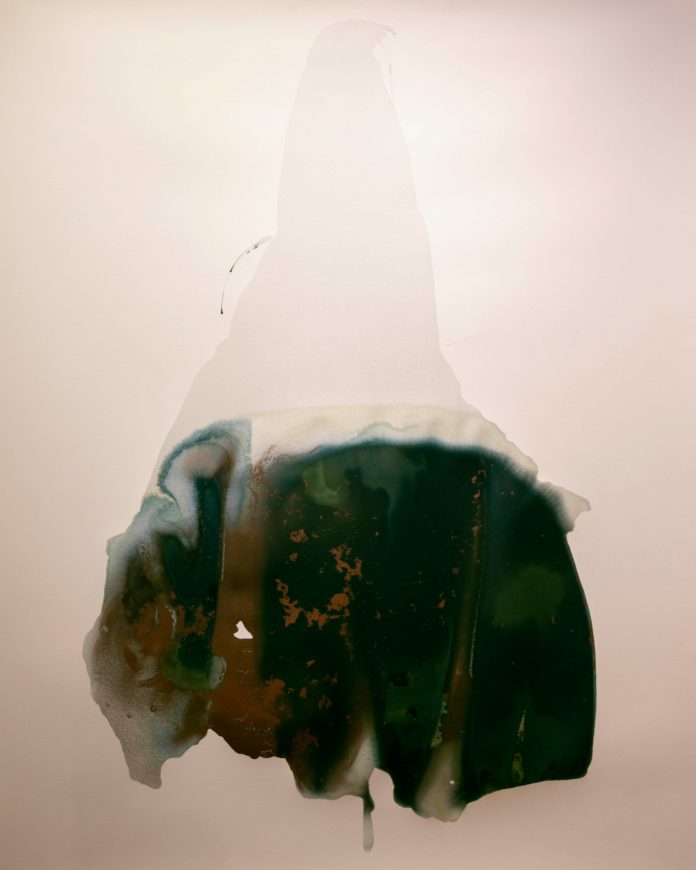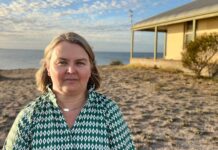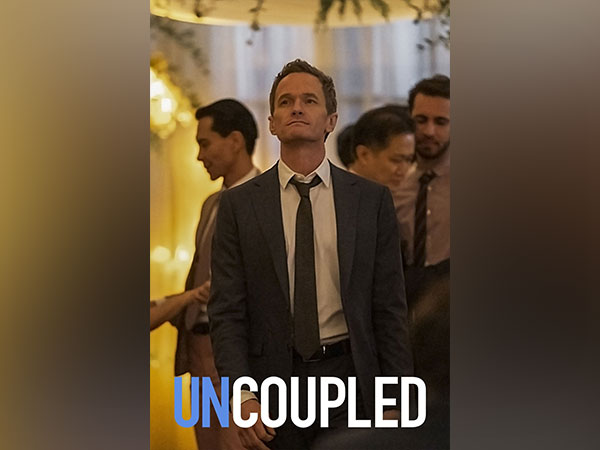
Less specific but equally watery is Alexandria, Va., artist Maggie Golightly Haslam’s abstract painting, made with watercolor and New York City harbor water. The aqueous picture, whose smudgy core mingles brown and deep green, memorializes the Lenape natives who once settled the harbor area, and also invokes the recent birth of the painter’s child.
Water is absent, but its presence or absence strongly suggested, in several photos. Katie Kehoe of Richmond photographs a small, ragged wooden pier she erected in an arid Nevada flatland that shows signs of once having been submerged. Marylander Ann Stoddard depicts literal “carbon footprints” on Assateague Island, where the human imprints contain traces of oil recently expelled by tankers. A dilapidated basketball court represents the neglect of Puerto Rico since the assaults of hurricanes Maria and Irma in a picture made by D.C.’s MichaelAngelo Rodriguez.
Ebbing away from the tidal theme, Upstate New Yorker Regina Quinn’s “Eden Burning” is a semiabstract painting over a monoprint whose orange brushstrokes, black drips and yellow backdrop combine to evoke last year’s wildfires in the Pacific Northwest. Forests disappear in a different way in D.C. cyber-artist Chris Combs’s “Clear-Cut,” in which electronic numbers suggest a declining number of trees by counting downward; the digits glow through a thin wooden panel reminiscent of ready-to-assemble furniture.
The most playful entry in the Diane Burko-curated show is Rachel Cole’s “Questions for a Dinosaur,” a video in which a woman in various guises and locations interrogates a person in a funky handmade dinosaur costume about extinction. The Brooklynite’s 109 rapid-fire queries run from “What does it feel like to go extinct?” to “What should I wear?” The dinosaur’s responses are not meant to put the questioner, or the viewer, at ease.
Turning Tides Through Sept. 11 at Target Gallery, Torpedo Factory, 105 N. Union St., Alexandria.
Essence of Summer
Steel, wood and ceramics assume a fecund profusion of forms in “The Essence of Summer,” a 15-artist show at Watergate Gallery. Like the venue’s previous summer group exhibitions, this one spills into the adjacent submerged plaza, which has space for bold, larger sculptures by Richard Binder, who works mostly in painted steel, and Jane Petit, whose 3D mosaics combine shards of marble and glass. Also beyond the gallery’s front door is a site-specific piece by Veronica Szalus, who wrapped undulating tendrils of netted wire in two colors around one of the structure’s support columns.
Dalya Luttwak, known for steel renderings of vines that are more literal than Szalus’s, turned to a different style during the height of the pandemic; she contributes two symmetrical arrangements of parts from metal ceiling fans. Much wilder are Joel D’Orazio’s two bristling nests of plastic zip ties, both in a rainbow of colors, although one is crowned in all black. Joan Konkel wraps abstract color-field paintings with rumpled metal mesh that distorts the underlying image; she also veers toward sculpture with “Tropical Tangle,” which is topped by sprigs of mesh twisted to resemble foliage.
Alex Kasten evokes nature on a tectonic scale with the single-color pieces of his 3D “Topography” series, whose stacked cedar pieces suggest highly stylized relief maps of mountainous areas. Inspired by stained glass windows yet incorporating up-to-date technology, Greg Nigel’s steel-framed wall sculpture is illuminated by LEDs that can pulse to various musical soundtracks.
A few pieces straddle indoor and outdoor. Within the gallery but seemingly meant for a garden, Gay Hanna’s working fountain drips water down a stone and metal column that’s topped with a carved, gold-leafed eye. Barbara Kobylinska’s whimsical sculptures of animals and flowers can be found both outside and in the gallery. The engagingly cartoonish creations are mostly painted ceramics, but with such touches as metal whiskers on the panther and a tuft of carpetlike hair atop the water buffalo. Such playful use of contrasting material may not be the show’s essence, but it is shared by a lot of these media-mixing artworks.
Essence of Summer Through Sept. 23 at Watergate Gallery, 2552 Virginia Ave. NW.
Kevin Rohde
As if to avoid the gazes of passersby, some of Kevin Rohde’s figurative sculptures pull their clothing over their heads. This is intriguing philosophically, and also impressive technically. The George Washington University instructor renders fabric’s pliable folds and drapes in earthenware, shaped clay that has been fired into permanent rigidity. The Baltimore-based artist, whose work is in the street-facing display windows of 355 POD Space Gallery, is a master of making the hard appear soft.
That includes skin and hair as well as clothing. Rohde’s painted figures have highly detailed, utterly individual characteristics; their eyes and mouths, beards and wrinkles, grimaces and bared teeth have a near-photographic verisimilitude. Many are in dynamic poses, often grasping lengths of material when not trying to vanish entirely into their clothing. Jackets, trousers and scarves demarcate the contested boundary between the self and the world.
There’s one other element to the artwork. It seeks to illustrate individuals’ responses to “ever changing social and environmental conditions,” notes the artist’s statement. Aside from those bits of cloth, such conditions are represented entirely by pigment. Hard-edged geometric patterns in bright colors are often painted on the figures, contrasting their naturalistic curves. One man appears to have stepped through a red web that has left its traces on his skin and clothing. Rohde’s players are highly specific, but the environment that shapes and scourges them is reduced just to color and shape.
Kevin Rohde Though Oct. 30 at 355 POD Space Gallery, 355 Rockville Pike, Rockville.








